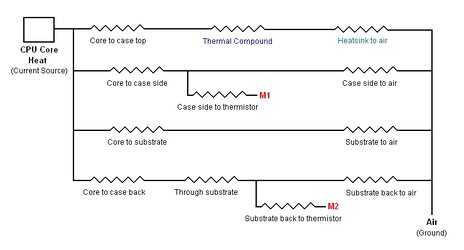Sonny has brought up some good points. Here's a little more on the subject of obtaining accurate CPU temps.
Any diode inside the chip will be far more accurate than a thermal probe placed outside the chip. Think about it, how accurately can you tell the temperature of an oven or a refrigerator with a thermometer mounted outside on the door? For more info read
Why Many Thermal Measurements Are Not Valid. As most of us already know, in-socket thermistors will not give you anything resembling an accurate temperature. “Oh but I put the probe next to the CPU core, it must be accurate!”
Think again. Here's an interesting
heatsink round up that illustrates the point.
Somehow or other, but the main conclusion is this: for hardcore overclocking, the readings of external thermal sensor are absolutely useless since they don't reflect the factual processor core temperatures.
You may find
Temperature Sensing Technologies a good read too.
Now that we have figured out the best place to read the temperature is inside the CPU die, another problem pops up. With PII and PIII CPUs, the sensor was in the hottest part of the chip. Here's what Intel has to say about
PIII diode placement. With P4s and Athlons the diode is no longer in the hottest part of the chip. A little more
reading from Intel on the subject. We have the same problems measuring temperatures inside the core when the diode is not in the hot spot as those outlined in Why Many Thermal Measurements Are Not Valid.
The only accurate CPU temperature measurements are from PII or PIII internal diodes provided you have a motherboard that can read the internal diode. There is no way for the end user to get an accurate temperature reading from an AMD CPU or a P4.
Furthermore for those of you with P4s, if you consider the last link from Intel, your CPUs are most likely throttling more often than you may realize.

